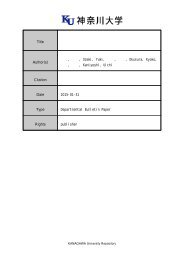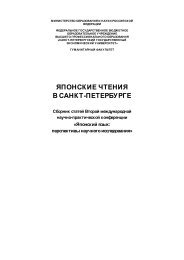to Learners with Special Educational Needs
e-textbook SEN
e-textbook SEN
You also want an ePaper? Increase the reach of your titles
YUMPU automatically turns print PDFs into web optimized ePapers that Google loves.
Pokrivčáková, S. et al. (2015). Teaching Foreign Languages <strong>to</strong> <strong>Learners</strong> <strong>with</strong> <strong>Special</strong> <strong>Educational</strong> <strong>Needs</strong>:<br />
e-textbook for foreign language teachers. Nitra: Constantine the Philosopher University. 128 p.<br />
ISBN 978-80-558-0941-0<br />
interchangeably <strong>to</strong> cover the particular pattern of difficulties experienced” (Mortimore, 2008, p.<br />
50). Specific learning disabilities, however, cover dyslexia as one type of specific difficulties<br />
along <strong>with</strong> e.g. dyspraxia or attention deficit disorder.<br />
It is important <strong>to</strong> realise that dyslexia is a specific learning disability that has neurological<br />
origin and cannot be cured. It is not a question of intelligence, intellectual abilities or age. The<br />
International Dyslexia Association defines dyslexia considering biological, behavioural, cognitive<br />
and environmental levels (Kormos & Smith, 2012, p. 24):<br />
Dyslexia is a specific learning disability that is neurological in origin.<br />
It is characterized by difficulties <strong>with</strong> accurate and/or fluent word<br />
recognition and by poor spelling and decoding abilities.<br />
These difficulties typically result from a deficit in the phonological<br />
component of language that is often unexpected in relation <strong>to</strong> other<br />
cognitive abilities<br />
and the provision of effective classroom instruction.<br />
Biological level<br />
Behavioural level<br />
Cognitive level<br />
Environmental level<br />
Dyslexia is a chronic, lifelong condition and “studies show definite brain differences<br />
between dyslexics and nondyslexics” (Wood, 2006, p. 18). As dyslexia may severely affect the<br />
self-perception the early identification is important (watch e.g. HBO Documentary Film Journey<br />
in<strong>to</strong> Dyslexia, 2011). It is very hereditarian. And it is many times unexpected as children are very<br />
bright but they have problems <strong>with</strong> acquiring a written language. It frequently happens that<br />
children are very frustrated, they are struggling very hard, before being diagnosed as they<br />
themselves as well as other people do not understand what the problem is. The pupils are<br />
usually described as low and/or lazy; sometimes they are labelled as disorganized, stupid,<br />
dummies.<br />
A lot of people are embarrassed <strong>with</strong> the dyslexia “label”; it happens that parents do not want<br />
<strong>to</strong> accept that their child is dyslexic. Hudson (2013) explains the positive aspects of dyslexia<br />
identification and possible labelling learners <strong>with</strong> dyslexia. He claims that people have <strong>to</strong><br />
“understand the talents that go along <strong>with</strong> dyslexia and those who have it in the way their brains<br />
operate. It’s a package of strengths, and some areas of challenge. More <strong>to</strong> the school system,<br />
however, is labelling is sometimes relieving <strong>to</strong> a child. And that’s true whether it’s a mental<br />
health issue or learning issue. Or a health issue that’s beyond a mental health issue. People need<br />
<strong>to</strong> get a handhold on something in order <strong>to</strong> know – it’s not about them, that whatever they are<br />
contending <strong>with</strong> it might be a challenge, is not a character flaw”.<br />
Early identification 1 is also important because “the brain is much more plastic in younger<br />
children and potentially more malleable for the rerouting of neural circuits” (Shaywitz, 2008, p.<br />
611-612). The symp<strong>to</strong>ms or behaviors associated <strong>with</strong> dyslexia can be observed and help the<br />
parent or teacher <strong>to</strong> suspect dyslexia.<br />
Concerning symp<strong>to</strong>ms associated directly <strong>with</strong> language we can mention that dyslexic<br />
children are late-talking, they start <strong>to</strong> speak late, they cannot tell the rhyming words, reverse<br />
letters and numbers (especially p and b, w and m, 3 and 5), they alter or leave out word parts,<br />
they have problem <strong>to</strong> break words in<strong>to</strong> their component, <strong>to</strong> discriminate sounds <strong>with</strong>in a word –<br />
phonological processing (d-o-g). There are also other than language (non-linguistic) symp<strong>to</strong>ms as<br />
e.g. confusion <strong>with</strong> before and after, left vs. right confusion, difficulty remembering and<br />
following directions, difficulty <strong>with</strong> mo<strong>to</strong>r skills and organisation, attention. Many dyslexic<br />
children show problems <strong>with</strong> handwriting, processing speed, working memory.<br />
“At the upper levels of the language hierarchy are components involved <strong>with</strong>, for example,<br />
semantics (vocabulary or word meaning), syntax (grammatical structure), and discourse<br />
(connected sentences). At the lowest level of the hierarchy is the phonologic module, which is<br />
dedicated <strong>to</strong> processing the distinctive sound elements of language. Dyslexia involves a<br />
1 „In 1994 Reid observed that about 15% of the children who were identified as having specifi c learning<br />
diffi culties were not identifi ed until they reached secondary education“ (Mortimere, 2008, p. 57).<br />
40






